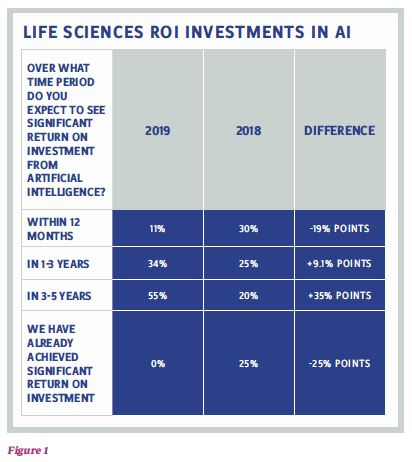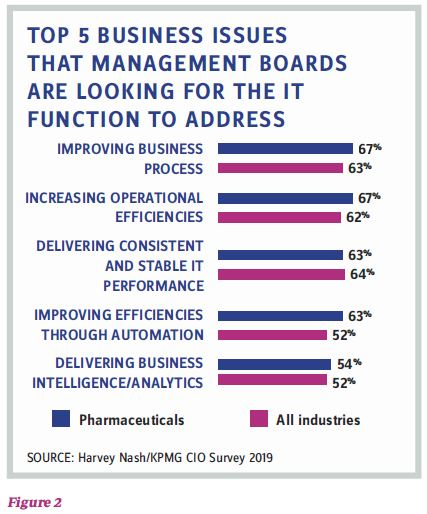Digital Transformation In The Life Sciences: The C-Suite Weighs In
By Katie Dahler & Justin Hoss

KPMG’s CEO Outlook found that U.S. life sciences CEOs are seeing delays in their return on investment in digital transformation technologies, such as AI, robotic process automation, and blockchain, among other examples. About 80 percent of life sciences CEOs are now expecting a return on investment in one to three years. In 2018, a quarter of CEOs in the industry said they had already seen a positive return on investment, but none said that in 2019. (See Figure 1)
Beyond financial returns, nearly half (49 percent) of life sciences CEOs — 47 percent across all industries — say investments made in personalizing the customer experience have not delivered the growth benefits that were anticipated.
Our survey found that progress is being made when it comes to implementing digital automation in the life sciences sector: 30 percent said some of their processes have been automated, 48 percent have started limited implementations, and 23 percent are doing pilot programs for AI.
While CEOs are seeing a bit of a delay in recouping their investments, they are not seeing these initiatives as sunk costs that cannot be recouped. Technology has a use case that resonates with life sciences executives, who need to improve efficiency across administration, marketing, regulatory compliance, and R&D functions.
It is still early for these emerging technologies to take hold, and the world of medicine demands evidence that cloud computing, data and analytics, blockchain, and other emerging technologies can transform how business and patient care are conducted. These technologies are more than just cost-cutting plays. They are part of an approach to refine drug development, engage patients, build trust in the pharma supply chain, and ultimately reshape business models that can build more value.

NEW TECHNOLOGIES REQUIRE NEW SKILLS
While we talk about the potential of this technology, life sciences CEOs are experiencing a reality check about how they invest in technology. Cloud computing, automation, AI, and blockchain represent massive jumps in the technological capabilities of organizations everywhere, but we cannot treat technology as a widget that gets bolted onto an organization with a business-as-usual approach. Chief information officers and chief technology officers are taking much more strategic roles in companies’ operations and the world of patient care to make the most from the tech investments. Capitalizing on the emerging technologies’ capabilities requires new talents. AI, coding, cybersecurity, IT management, and other technical skills are very important, regardless of the industry in which they are being deployed.
Pharmaceutical CIOs in the Harvey Nash/KPMG survey were ahead of their peers outside the industry when it came to business issues that management boards want IT to address: improving business processes, increasing operational efficiency, improving efficiencies through automation, and delivering business intelligence/analytics. (Figure 2) However, a vast majority of life sciences executives (80 percent) surveyed see technology as a job creator rather than a job killer. Office work and administrative roles will change, and people will be deployed in a way to improve value within an organization as greater volumes of information are increasingly shared digitally. The nature of work is changing in pharma. It’s becoming apparent that humanistic skills are needed — curiosity, understanding, compassion, and intuition.
USING TECHNOLOGY TO CREATE PERSONALIZED EXPERIENCES
While pharma executives have shown a willingness to embrace technology, medical care needs to catch up to retailing, entertainment, travel, and the array of other organizations that have used these technologies to create more personalized experiences. The amount of spending on healthcare makes it crucial to be more personalized to improve the patient experience and treatment outcomes while cutting waste from ineffective treatments.
Beyond business processes that cut across industries, life sciences executives see technology transforming patient and physician engagement — offering “beyond-the- pill” services and building loyalty among patients/customers. Wearable devices can provide a steady stream of data from an individual patient and a tsunami of data from the multitude of patients using smartwatches, mobile phones, continuous glucose monitors, and other gadgets that collect health data to create additional engagement opportunities. In this highly decentralized care approach, drugmakers have an opportunity to more effectively communicate with patients at all levels of medical complexity.
AI will certainly have a role in risk stratification for patients and offering guidance for a more “predictive” approach to healthcare. Risk stratification and the increased usefulness of genetic information will help drugmakers create personalized medicines, making Big Data and analytic tools necessities to develop the right drugs at the right dose for the right patients.
When drugs finally reach the market, AI and bots can have a hand in identifying patients who are not adhering to treatment. However, it may take more than an automated email/text message to remind a patient and provider that medications are not being used. A representative from the drugmaker may be the one who calls the patient or collaborates with a doctor or pharmacist to help address why a patient is not adhering to treatment.
Side effects management, social circumstances, or a person’s living environment can serve as barriers to helping patients to stay on treatment. Addressing this need strays far from being the creative laboratories that develop innovative cures, but the healthcare system is evolving, and providers are taxed with an aging population and constrained reimbursements. Pharma has an opportunity to help, and technology can help advance efforts for patient care.
LEVERAGING THE BENEFITS OF DIGITAL TECHNOLOGY
Digital technology should be leveraged for its strengths: the ability to automate certain functions and the ability to take copious amounts of information to be applied to routine tasks, such as clinical trial reporting, regulatory filings, and capturing prescribing patterns. On a more advanced level, the analytics can accelerate drug discovery by sorting the genetic combinations to create more precise medicines. These same analytics capabilities can increase personalization when it comes to customer engagement. In these cases, it makes sense to let the machines do the work.
At the same time, a more wired healthcare system is unavoidable as data becomes much more easily gathered from the array of devices available to patients, enabled by greater connectivity between healthcare providers and the ability to more effectively share data, whether it is from clinical trials or patients themselves. Electronic health records, mobile phones, and wearable devices have changed the landscape for gathering and sharing this data. Sharing information across the care continuum creates opportunities to improve patient outcomes.
Ultimately, the ability of technology to transform the delivery of healthcare will rest upon a few key tenets that are shaping the industry:
- Data revolutionizes the realm of personalized medicine. Genetics represents a road map of biologic processes, and computing is helping to untangle genes connected to medical conditions, as well as developing medications. Beyond electronic health records that can help track and measure the quality and cost of care, data can be gathered about a patient’s social circumstances and environment. Phones already can alert people to weather conditions, but they can provide much more effectively tailored alerts for the asthma sufferer on a day with a high pollen count.

- Cloud migration has allowed CIOs and CTOs to become less worried about data storage but more driven on how data and technology support the business. Most enterprise resource planning software is cloud-based, allowing greater scalability and less maintenance for the array of applications used by businesses. The biggest cloud providers have spent billions to maintain security on a scale that few companies can match.
- Pay for performance is still emerging in healthcare and pharma. However, a new drug that costs exponentially more than a low-cost generic drug needs to show a business case — via advanced analytics — about why it should be on a payer’s formulary.
- Regulatory affairs are as important as ever. Beyond using technology to automate certain filings, pharma remains one of the most highly regulated sectors for manufacturing and how its products are marketed. In 2023, drugmakers, wholesalers, and pharmacies will need to be able to have track and trace capabilities on medications throughout the supply chain. Cybersecurity not only protects intellectual property and employee and financial information, but it is also needed to protect patient information to prevent HIPAA violations.
Addressing the question that we raised at the top of the story, the digital rose does still have a bloom, and the key now for the industry will be to understand how to make it truly blossom.
KATIE DAHLER leads KPMG’s Life Sciences Advisory practice. She has supported healthcare and life sciences companies with organizational strategy and change management initiatives for more than 20 years.
JUSTIN HOSS is a principal in KPMG’s Advisory practice and the national technology sector leader for the Life Sciences practice. He has 20+ years of experience in strategy, mergers, acquisitions, and divestitures, integrated business transformation, package strategy and implementations, vendor selection, information technology, and process improvement.
